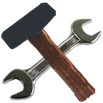Apartment repair - troublesome, requires patience, skill and some serious spending. You can certainly trust the repair to professionals, but there is a less expensive option - to repair their own hands. Many people know how pokleit wallpaper, but how to put the tiles in the bathroom or in the kitchen? To some this may seem very complex, but there are those who will help the detailed procedure for laying ceramic tiles.
Let's begin!
To get started, you need a tool: the level spreader for regular and special tile adhesive for tiles (wall and floor), crosses, grout, and of course the tiles.
Thus, we begin preparatory work: remove old tiles, if any. Ceramic tiles laid on a level surface, so the next step - leveling walls and floor.
The most common and easiest option leveling walls — use plaster. This method is good because it reduces the space almost as plaster is applied only on the uneven surface. For maximum flat surface use special guide rails or beacons. This will make the wall as smooth, in addition, beacons are not extracted from the wall and after work support plaster, however, there is a view that lighthouses in the walls begin to rust and spoil it all, there will be rusty spots, bumps. In our case the spots for the tiles we will not see, so let yourself sit in the wall and support. Plaster applied to a small portion of the wall to dry out a bit and remove the parts that are beyond the level of lighthouses, movements from the bottom up without strong pressure. Be careful, even slight pressure can remove the excess. And so on all the walls, and then give the plaster to dry.

If you show such a complex way, use drywall. Drywall sheets are attached to the crate, or directly to the wall. Use moisture resistant plasterboard (it is green), shpaklyuyut joints, the entire surface of the soil (preferably several times). Small minus this method - reducing space, so it should be avoided in small spaces.
Before laying the tiles on the floor it should also be aligned. Machine level. If the difference is, it is best to use a mixture of self-leveling. Dilute the mixture, as indicated on the package (to the consistency of sour cream) is poured to the mixture evenly distributed, and there was no lump, special laminating roller. The mixture was dried for a day.
Well, the surface is ready, you can go to laying tiles. Better to start with the walls, because the tile laid on the floor, can be contaminated, and the joints get debris, and do not forget that the accidental fall of a tool or heavy material, can cause cracks in the tile.
Weighing the pros and cons, we determine the angle from which we will begin to have less waste. With the output level of the horizontal line and it will place the first row of tiles. Dilute the adhesive, but not the whole bag, as it dries quickly. Before laying the first tile in the corner fasten special corner, from which we will begin. Apply glue to the wall or tile (does not matter) using a notched trowel, putting tiles on the wall. Gently presses or taps with a rubber mallet to tile attached itself evenly over the entire surface. The joints were the same between the tiles inserted special plastic crosses. Do not forget to remove the excess glue that comes out from under the tiles.
No matter how you tried, but the tiles to be clipped. Prirezku tile can be done, in their absence, you can use glass cutter. If the tile is necessary to make a hole, use a drill with a special nozzle for round holes, for straight cuts needed Bulgarian Diamond Circle. Angle cutting of hiding behind the edge of the wall adjacent to the neighboring tiles or special closed area, cutting of the remaining closed fittings. The edges of the tiles hide under shear wall tiles, leaving this space between the wall and floor tiles to give a smooth seam, which does not require the use of the plinth.
A few days later clobbered seams. Sutures are cleaned from dust and glue residue, floor tiles clean. Dilute and rub grout into the joints with a rubber spatula. Remove the excess with a damp sponge.
That's it! The next day to clean tile, installed plumbing, put furniture and you can use the results of your labor!
 Full-Repair.com
Full-Repair.com